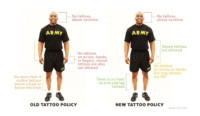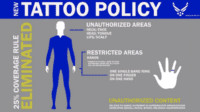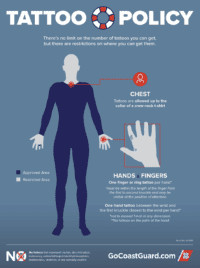Does the military allow tattoos? Yes, the military allows tattoos, but with certain restrictions that vary slightly between branches; understanding these regulations is key for both current and prospective service members. At tattooat.com, we’re here to guide you through the evolving world of military tattoo policies, ensuring you’re well-informed about what’s acceptable and what’s not, so you can confidently express yourself while honoring your commitment to service. Explore our extensive collection of tattoo designs and connect with talented artists to create meaningful body art that aligns with both your personal style and military guidelines.
1. What Are the General Tattoo Restrictions Across Military Branches?
Generally, all branches of the military prohibit tattoos on the face, head, scalp, tongue, lips, and eyelids. However, specific regulations and exceptions exist within each branch. Staying informed about these nuances is essential for service members and aspiring recruits.
Across the U.S. military, there are some common-sense prohibitions. It should come as no surprise that the Army, Navy, Air Force, Marine Corps, and Coast Guard do not allow tattoos anywhere on the:
- Face
- Head
- Scalp
- Tongue
- Lips
- Eyelids
These restrictions are in place to maintain a professional image and prevent any potential distractions or misinterpretations. However, beyond these broad restrictions, policies vary slightly between branches.
2. What Are the Specific Neck Tattoo Policies in the Military?
The Navy stands out as the only branch that permits a single neck tattoo, provided it doesn’t exceed 1 inch in diameter. All other branches generally prohibit neck tattoos that are visible above a crew neck shirt.
 Navy Tattoo Regulations: Acceptable Neck Tattoo
Navy Tattoo Regulations: Acceptable Neck Tattoo
The Marine Corps provides a very specific definition, stating that the neck is “the portion of the body above the collarbone in the front area, above the seventh cervical vertebrae (C7) in the back area.” This level of detail ensures clarity and consistency in enforcing the policy. Other branches follow similar guidelines, but it is best to check with a recruiter before committing to any ink.
3. What Hand Tattoo Policies Do the Different Military Branches Have?
While all branches prohibit general hand tattoos, exceptions are made for finger ring tattoos, allowing one per hand in the Army, Navy, Coast Guard, and Marine Corps. The Air Force permits only one finger ring tattoo, on one hand. The Coast Guard uniquely allows one additional hand tattoo, no larger than 1 inch in diameter, between the wrist and first knuckle.
Despite the general prohibition of hand tattoos, exceptions are made for finger ring tattoos. The Army, Navy, Coast Guard, and Marine Corps allow one finger ring tattoo per hand. However, the Marine Corps specifies that the finger ring tattoo cannot exceed 3/8 inch in width. The Coast Guard specifies that finger ring tattoos cannot exceed the length of the finger from the first to second knuckle. The Air Force allows a single finger ring tattoo, but on one hand only.
 Air Force Tattoo Policy: Finger Tattoo Exception
Air Force Tattoo Policy: Finger Tattoo Exception
The Coast Guard is the only service branch that permits one other hand tattoo. This second kind is allowed between the wrist and first knuckle, as long as it’s not bigger than 1 inch in diameter.
These nuanced regulations highlight the importance of consulting official guidelines and seeking clarification from military authorities to ensure compliance.
4. What Content Is Prohibited in Military Tattoos?
The military strictly prohibits tattoos that are racist, sexist, extremist, anti-American, or ethnically or religiously discriminatory. Tattoos signifying gang affiliation or suggesting illegal drug use are also forbidden.
Service Members must avoid tattoos that are:
- Racist
- Sexist
- Extremist
- Anti-American
- Ethnically or religiously discriminatory
- Obscene
Tattoos may also not:
- Signify gang affiliation
- Suggest illegal drug use
Each branch specifies these prohibitions a bit differently. The Coast Guard, for example, bans expressions of “Violence” and “Lawlessness.” The Air Force condemns designs “that are prejudicial to good order and discipline, or of a nature that may bring discredit upon the Air Force.” The new Marine Corps policy emphasizes an expanded definition of “terrorism” to include the domestic kind. Tattoos may not “advocate, engage in, or support the forceful, violent, unconstitutional, or otherwise unlawful overthrow of the government of the United States, any state, commonwealth, district, or territory of the United States.”
5. How Does the Military View Other Forms of Body Art?
The military generally prohibits other forms of body art like branding, burning, scarring, or mutilation. The Coast Guard, for example, prohibits “intentional alterations and/or modifications to a member’s body (e.g., scarring, excessive ear piercing/stretching, tongue splitting, beneath the skin decorative implants, decorative tooth plating/engraving, etc.).”
All the service branches have something to say about other forms of body art, including branding, burning, scarring, or mutilation. As the Coast Guard puts it, sailors may not have “intentional alterations and/or modifications to a member’s body (e.g. scarring, excessive ear piercing/stretching, tongue splitting, beneath the skin decorative implants, decorative tooth plating/engraving, etc.).”
6. How Have Military Tattoo Policies Evolved?
Military tattoo policies have significantly evolved, relaxing restrictions to align with societal norms and address recruitment and retention challenges. Once stringent rules about the size, location, and content of tattoos have been eased to accommodate the increasing prevalence of tattoos among young adults.
It used to be that service branches banned tattoos exceeding 25% of the body parts they decorated. There were also prohibitions on tattoos below the knees or ankles and separate policies for officers and enlisted. These changes reflect a growing understanding of the importance of individual expression and the need to attract a diverse pool of talent.
7. How Does the Interpretation of Tattoo Policies Work in the Military?
Interpreting tattoo policies involves scrutiny at various levels, from commanding officers to the Department of Defense, to ensure compliance with regulations. Commanders assess tattoos to ensure they do not violate content restrictions, with the ultimate goal of maintaining good order, discipline, and a professional image.
 Coast Guard Tattoo Restrictions: Content Matters
Coast Guard Tattoo Restrictions: Content Matters
All this means that interpretation must come into play when scrutinizing tattoos. The level scrutiny rises from commanding officers up to the highest levels at the DoD.
8. Why Are Military Tattoo Policies Changing?
The primary drivers behind changes in military tattoo policies are recruitment and retention. As tattoos become more mainstream, the military recognizes that strict policies can deter potential recruits and lead current service members to leave. By relaxing these rules, the military aims to broaden its appeal and retain valuable personnel.
Nearly half of young adults have tattoos, and many have several. The new “Marine Corps Bulletin 1020” emphasizes balance between decorum and practicality: “The American people expect Marines to be disciplined, physically fit, and ready to accomplish any mission. They also expect Marines to represent the nation they are sworn to protect.”
The new policy, the bulletin goes on to say, “ensures that the Marine Corps maintains its ties to the society it represents and removes all barriers to entry for those members of society wishing to join its ranks.”
9. What Are the Implications of the Updated Marine Corps Tattoo Policy?
The updated Marine Corps tattoo policy allows “sleeve” tattoos (whole arm) and permits officers more than four visible tattoos in uniform, reflecting a significant shift towards greater acceptance of body art. These changes aim to strike a balance between maintaining decorum and attracting a wider pool of qualified individuals.
Last week, the Marine Corps revised its policy, allowing the “sleeve” (whole arm) tattoo and also permitting officers more than four tattoos visible in uniform. Both officers and enlisted can now tat themselves up as much as they want, as long as it’s not on the face or neck. And hands may sport only one finger ring tattoo.
10. Where Can I Find the Official Military Tattoo Regulations?
Official military tattoo regulations can be found in service-specific publications, such as Marine Corps Bulletin 1020, US Army Uniform Regulations, US Navy Uniform Regulations, Coast Guard Tattoo Policy, and Air Force Dress and Personal Appearance guidelines. These documents provide comprehensive details on permissible tattoo locations, content restrictions, and other relevant policies.
For more information about the latest dress and appearance regulations of each service branch, see:
- “Updates to Marine Corps Tattoo Policy”
- “Wear and Appearance of US Army Uniforms and Insignia”
- “United States Navy General Uniform Regulations, Chapter Two, Personal Appearance”
- “Military Members: Expanded Tattoo Policy (Coast Guard)”
- “Dress and Personal Appearance of Air Force and Space Force Personnel”
11. Military Tattoo Policies: A Detailed Look
Navigating the world of tattoos within the military requires a keen understanding of the regulations set forth by each branch of service. These policies, while evolving, provide clear guidelines on what is acceptable in terms of tattoo placement, size, and content. Let’s delve into the specifics of these policies, ensuring that both current and prospective service members can confidently express themselves while adhering to military standards.
11.1. Understanding Placement Restrictions
One of the most critical aspects of military tattoo policies is understanding where tattoos are permitted on the body. While the general consensus across all branches is that tattoos are prohibited on the face, head, scalp, tongue, lips, and eyelids, the nuances lie in the exceptions and specific interpretations of these rules.
For instance, the Navy stands alone in allowing a single neck tattoo, provided it does not exceed 1 inch in diameter. The Marine Corps, on the other hand, offers a precise definition of the neck area, clarifying that it includes the portion of the body above the collarbone in the front and above the seventh cervical vertebrae (C7) in the back. This level of detail ensures there is little room for ambiguity when enforcing the policy.
11.2. Hand Tattoo Exceptions
Hand tattoos are another area where military tattoo policies exhibit variations. While a blanket prohibition on hand tattoos exists across all branches, exceptions are carved out for finger ring tattoos. The Army, Navy, Coast Guard, and Marine Corps each allow one finger ring tattoo per hand. However, the Marine Corps stipulates that these tattoos cannot be wider than 3/8 inch, while the Coast Guard specifies that they cannot exceed the length of the finger from the first to second knuckle.
The Air Force takes a more conservative approach, permitting only a single finger ring tattoo, and only on one hand. Adding another layer of complexity, the Coast Guard is the sole service branch that permits an additional hand tattoo, no larger than 1 inch in diameter, located between the wrist and the first knuckle.
11.3. Content Matters
Beyond location, the content of tattoos is of paramount importance in the military. All branches strictly prohibit tattoos that are deemed racist, sexist, extremist, anti-American, or ethnically or religiously discriminatory. Additionally, tattoos that signify gang affiliation or promote illegal drug use are strictly forbidden.
The Coast Guard, for example, explicitly bans expressions of “Violence” and “Lawlessness,” while the Air Force condemns designs that are “prejudicial to good order and discipline, or of a nature that may bring discredit upon the Air Force.” The Marine Corps’ updated policy expands the definition of “terrorism” to include domestic terrorism, prohibiting tattoos that advocate or support the forceful overthrow of the U.S. government.
11.4. Other Forms of Body Art
Military regulations extend beyond tattoos to encompass other forms of body art. Branding, burning, scarring, and mutilation are generally prohibited across all branches. The Coast Guard’s policy is particularly explicit, forbidding “intentional alterations and/or modifications to a member’s body (e.g., scarring, excessive ear piercing/stretching, tongue splitting, beneath the skin decorative implants, decorative tooth plating/engraving, etc.).”
11.5. The Evolving Landscape of Military Tattoo Policies
Military tattoo policies have undergone significant transformations in recent years, reflecting broader societal shifts and the military’s efforts to adapt to changing demographics. The once stringent rules governing tattoo size, location, and content have been relaxed to accommodate the increasing prevalence of tattoos among young adults.
This evolution is driven primarily by the need to attract and retain qualified personnel. As tattoos become more mainstream, the military recognizes that overly restrictive policies can deter potential recruits and prompt current service members to seek opportunities elsewhere. By loosening these rules, the military aims to broaden its appeal and maintain a competitive edge in the recruitment landscape.
11.6. The Interpretation Process
Interpreting and enforcing military tattoo policies is a multi-tiered process, involving scrutiny at various levels, from commanding officers to the Department of Defense. Commanders are tasked with assessing tattoos to ensure they comply with content restrictions, with the overarching goal of maintaining good order, discipline, and a professional image.
This interpretation process underscores the subjective nature of tattoo policies, as individual interpretations may vary. However, the military strives to ensure consistency and fairness in the application of these regulations.
11.7. Accessing Official Guidance
To navigate the intricacies of military tattoo policies, it is essential to consult official guidance documents published by each branch of service. These documents provide comprehensive details on permissible tattoo locations, content restrictions, and other relevant policies. Some key resources include:
- Marine Corps Bulletin 1020
- US Army Uniform Regulations
- US Navy Uniform Regulations
- Coast Guard Tattoo Policy
- Air Force Dress and Personal Appearance guidelines
By staying informed and seeking clarification when needed, service members and aspiring recruits can confidently express themselves through body art while upholding the standards and values of the U.S. military.
12. Tattoo Guidelines & Military Service: FAQs
Confused about tattoos and military service? Here are some frequently asked questions to help clear things up:
12.1. Can I join the military if I already have tattoos?
Yes, you can join the military if you already have tattoos, but they must comply with the regulations of the specific branch you wish to join. Restrictions apply to tattoo placement, size, and content.
12.2. What happens if I get a tattoo that violates military policy after enlisting?
If you get a tattoo that violates military policy after enlisting, you may face disciplinary action, including being required to remove the tattoo at your own expense or even separation from service.
12.3. Are there waivers for tattoos that don’t quite meet military standards?
Waivers for tattoos that don’t quite meet military standards are rare and typically only granted in exceptional circumstances. The decision to grant a waiver rests with the individual branch of service.
12.4. How often do military tattoo policies change?
Military tattoo policies can change periodically, so it’s essential to stay updated on the latest regulations from your specific branch of service.
12.5. Can I get a tattoo while on active duty?
Yes, you can get a tattoo while on active duty, but it must comply with current military tattoo policies. Failure to do so can result in disciplinary action.
12.6. Do military tattoo policies apply to reservists and National Guard members?
Yes, military tattoo policies generally apply to reservists and National Guard members while they are in uniform or on duty.
12.7. Are there any exceptions for medical or religious tattoos?
Exceptions for medical or religious tattoos may be considered on a case-by-case basis, but they are not guaranteed. You should consult with your chain of command for guidance.
12.8. Can I cover up a non-compliant tattoo with clothing or bandages?
Covering up a non-compliant tattoo with clothing or bandages may be a temporary solution, but it is not a substitute for complying with military tattoo policies.
12.9. Are there any resources available to help me understand military tattoo policies?
Yes, resources are available to help you understand military tattoo policies, including official publications from each branch of service and guidance from recruiters and career counselors.
12.10. Who can I contact if I have questions about military tattoo policies?
If you have questions about military tattoo policies, you can contact a recruiter, career counselor, or your chain of command for clarification and guidance.
13. Tattoo Designs That Honor Military Service
Expressing pride and commitment through ink can be a powerful way to honor military service, but it’s crucial to choose designs that respect regulations. Explore meaningful tattoo ideas that comply with military standards, allowing you to showcase your dedication with dignity and style.
13.1. Patriotic Symbols
Embrace classic American imagery such as the American flag, bald eagles, and patriotic quotes. These designs are timeless and universally recognized as symbols of national pride.
13.2. Military Branch Emblems
Show your allegiance to your specific branch of service with a tattoo of its official emblem. Whether it’s the Army star, the Navy anchor, the Air Force wings, the Marine Corps eagle, globe, and anchor, or the Coast Guard shield, these emblems represent the unique identity and values of your branch.
13.3. Unit Patches and Insignia
Honor your specific unit or division with a tattoo of its patch or insignia. These designs not only showcase your pride in your unit but also serve as a reminder of the bonds forged with your fellow service members.
13.4. Military Ribbons and Medals
Commemorate your achievements and awards with a tattoo of your military ribbons and medals. These designs recognize your accomplishments and sacrifices during your time in service.
13.5. Memorial Tattoos
Pay tribute to fallen comrades or commemorate significant events with a memorial tattoo. These designs often incorporate names, dates, and symbolic imagery to honor the memory of those who have served.
13.6. Nautical Stars
Embrace the symbolism of nautical stars, which have long been associated with sailors and navigation. These designs represent guidance, protection, and the journey home.
13.7. Dog Tags
Get a tattoo of your dog tags as a permanent reminder of your service and identity. These designs often include your name, service number, and other personal information.
13.8. Roman Numerals
Incorporate Roman numerals to represent significant dates or events in your military career. These designs are subtle yet meaningful, allowing you to commemorate important milestones in a discreet manner.
13.9. Geometric Designs
Opt for geometric designs that incorporate military-themed elements such as compasses, maps, and navigational symbols. These designs are modern and visually appealing, offering a unique way to express your military connection.
13.10. Inspirational Quotes
Choose an inspirational quote that resonates with your military experience and values. Whether it’s a quote from a famous military leader, a passage from a patriotic poem, or a personal mantra, these designs can serve as a source of strength and motivation.
14. Find Inspiration and Guidance for Military-Friendly Tattoos at Tattooat.com
Ready to explore the world of military-friendly tattoos? Visit tattooat.com for a wealth of inspiration, resources, and guidance to help you express your pride and commitment while adhering to military regulations.
At tattooat.com, we understand the importance of self-expression and honoring your military service. That’s why we offer an extensive collection of tattoo designs, connect you with talented artists who understand military guidelines, and provide informative articles and resources to ensure your ink aligns with both your personal style and military regulations.
14.1. Extensive Tattoo Design Gallery
Browse our vast gallery of tattoo designs, featuring a wide range of military-themed imagery, patriotic symbols, and inspirational quotes. Whether you’re looking for a classic design or something more unique, you’re sure to find inspiration that resonates with your military experience.
14.2. Connect with Talented Artists
Find skilled tattoo artists who specialize in military-themed designs and understand the nuances of military tattoo policies. Our directory makes it easy to connect with artists who can bring your vision to life while ensuring your tattoo complies with regulations.
14.3. Informative Articles and Resources
Access a wealth of informative articles and resources on military tattoo policies, design ideas, and aftercare tips. Stay updated on the latest regulations and trends to ensure your ink remains compliant and looks its best.
14.4. Personalized Recommendations
Receive personalized tattoo recommendations based on your branch of service, interests, and style preferences. Our experts can help you find the perfect design to honor your military experience while adhering to regulations.
14.5. Community Support
Connect with a community of fellow service members and tattoo enthusiasts who share your passion for ink and military pride. Share your designs, ask questions, and get inspired by others who have successfully navigated the world of military tattoos.
15. Your Next Steps
Ready to take the next step in your tattoo journey? Explore tattooat.com today and discover the perfect design to express your pride, honor your service, and stay within regulations. Let us help you find the inspiration, guidance, and artistic talent you need to make your tattoo dreams a reality. Whether you’re seeking a classic military emblem or a unique design that reflects your individual story, tattooat.com is your ultimate resource for all things military tattoos.
Address: 1825 SW Broadway, Portland, OR 97201, United States.
Phone: +1 (503) 725-3000.
Website: tattooat.com.
